Unitedhebrewth.org will occasionally feature voices from the congregation and community on social justice from a Reform Jewish perspective. Here, Terry Fear recounts her February visit with husband Steve to the site of the Dakota Access Pipeline protest near Cannon Ball, N.D.
“You shall administer truth, justice and peace in your gates.” (Zechariah 8:16)
Rabban Shimon ben Gamliel said, “The world is sustained by three things: Justice, Truth and Shalom.”
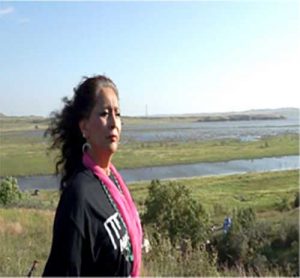
I especially identify with acts of social justice — not that I have ever actively sought activist opportunities. As a teenager, I watched civil rights movement protests on television from the safety of our living room. By the time I was old enough to participate, I thought the social upheaval of the 1960s and 1970s was over. Living in the rural Midwest lulled me into a false sense that America now provided equal opportunity to all.
But the current social unrest compounded by the lack of basic civility in the last election cycle has released my passion for social justice: my core beliefs have been challenged. I recalled that within our proud patriotic American narrative lies our historical mistreatment (I would use the term “genocide”) of the Indigenous People.
Standing Rock protest resonates strongly
When my husband Steve and I started to follow the Standing Rock Protest in North Dakota, we realized the Sioux peoples’ stand against the “black snake” of the Dakota Access Pipeline (DAPL) resonated strongly within us. (I encourage you to read Ladonna Allard’s account of the Whitestone Massacre.)
Steve absolutely insisted we head out to the Standing Rock protest camp. And so I was challenged: would this comfortably retired school teacher put feet to her passion?
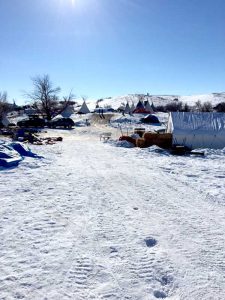
After two false starts in January, we loaded subzero sleeping bags and a donation of tarps and ropes and headed northwest to Bismarck, N.D., on February 1. Our intent: visit Sacred Stone Camp, spend the night in the back of our car and leave tarps, ropes & sleeping bags with the water protectors before we left for home. My goal: Don’t leave a footprint. Don’t get in the way. Respect the Native Peoples. Remember that as a white European, this isn’t my show — I’m an extra with a walk-on, walk-off part.
After reaching Bismarck in the early afternoon of February 2 (our 43rd wedding anniversary), we decided to be our own “forward observers.” We would find the camp and tell the water protectors that we would like to come back the next day to stay for 24 hours.
By chance, a car we were following turned into what we thought was Standing Rock Camp. But it was a smaller camp, Sacred Stone. Again, by chance, two indigenous water protectors were at the entrance.
These young men welcomed us, two (old) Europeans from Illinois. What could we possibly have to offer water protectors who are in a sacred struggle for their ancestral land and water? I felt out of place and in the way. They encouraged us to come back, no questions asked. But they were firm — no sleeping in the car; the weather was too cold.
Eagle Star offers welcome
The older man introduced himself as “Eagle Star” and instructed us to ask for him when we returned. The men left us with a warning: in the morning, we should check our car to make sure no one had vandalized it during the night. DAPL protestors are not seen favorably by the citizens of Bismarck.
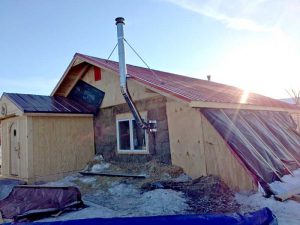
Yet, as two (old) Europeans, we blended well in Bismarck. At the hotel, the car dealership (we had weather-related car issues), and the diner, we were met with friendly, helpful and kind people who believed we were celebrating our anniversary with North Dakota siteseeing.
Back at the Sacred Stone Camp the next morning, we had to pass through an improvised security checkpoint. Two water protectors and an old car pulled across the road to block the camp entrance. Once they contacted Eagle Star, the car was moved, allowing us to pass into the outer camp.
It was here we unloaded our donation and were introduced to a chief of the Sioux people. He told us about the sacredness of the land. Sioux ancestors are buried in the land where the pipeline will pass. He also pointed out a distant hill where he said DAPL snipers were positioned — over a camp filled with unarmed men, women and children. This was not the America I knew. But it was where I needed to be, experiencing the America of the Lakota Sioux on the Standing Rock Reservation.

After passing through another security checkpoint, this one a locked cattle gate across the path, we drove down a hill to the Sacred Stone Camp. There, beautiful majestic tepees and squat humble yerts sat at the confluence of the Cannonball and Missouri rivers.
We spent the day meeting people as we walked through Sacred Stone Camp. Most were Caucasian, in their 20s and 30s, passionate about their cause and very welcoming. They thanked us for joining them, if even for a day. We had the privilege of hearing Ladonna Bravebull Allard speak. She loves these “kids” as her own.
Shabbat at Sacred Stone Camp
Erev Shabbat was spent in Eagle Star’s Mongolian yert, which actually came to the camp from Mongolia. This Lakota water protector gave up his shelter so complete strangers had a place to sleep. I’m sure he stayed with friends, but we will never forget his kindness.
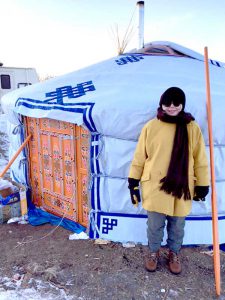
We left the next morning while it was still dark. No one in the camp was stirring. Huge bright halogen construction lights lit up the sky on the other side of the river, at the DAPL project site. As we stood among the Sacred Stone Camp’s tepees, we recognized how vulnerable the water protectors were with only an old car and a cattle gate keeping them safe. The beauty of the tepees and the peace of early Shabbat morning were only magnified in contrast to the DAPL site.
These are my memories and impressions of the Sacred Stone Camp. I recognize my bias favors the Lakota People’s cause. I admire them for standing up for the land and water in their role as David against the DAPL Goliath. I also understand the people who support DAPL are good people, wanting the jobs and improved economy the pipeline will bring.
Note: A few hundred protestors remain at Standing Rock after a federal judge ruled the Dakota Access pipeline project may move forward. Meanwhile, on March 7, Standing Rock activists began a week of protests in Washington, D.C.
“The arc of the moral universe is long, but it bends toward justice.” (Martin Luther King Jr.)
“Remember, truth and justice ultimately always win.” (Arianna Huffington)
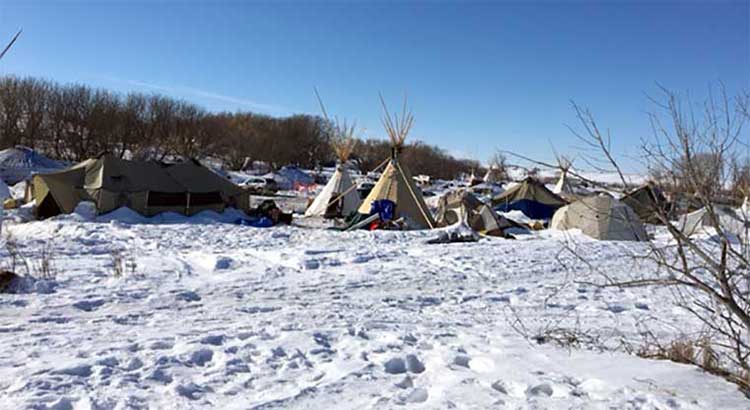
Excellent article, Terry. So proud of you.
Thanks for reading and commenting, Toni! We’ll pass your compliment along to Terry!